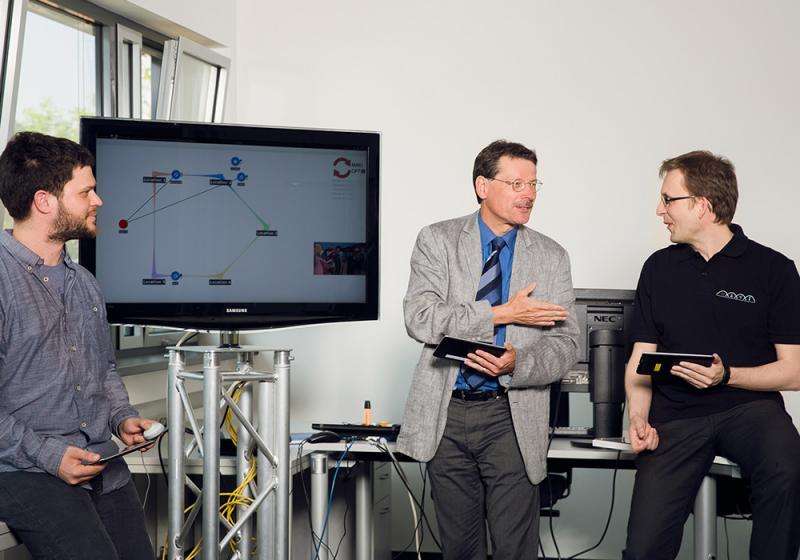Researchers developing dynamic mechanisms to maintain the web's enormous performance capability

Every internet user knows the situation. Just when you find your favourite TV show on YouTube and press play, the video quivers and hangs because the network is overloaded. Or even worse, the deciding goal in the final game of the World Football Cup reaches your TV streamer later than your neighbours' due to so-called latencies, that is, delays in transmitting the game. More and more data, users, apps, end devices, new forms of communication like hashtags and flashmobs and augmented reality games like Ingress are pushing the internet to the borders of its capacity and sometimes bringing it to a standstill.
"Nowadays the internet has become a driving force for our society and it will continue to cause serious upheavals", Professor Ralf Steinmetz director of the German Research Foundation's collaborative research centre MAKI – Multi-Mechanism Adaptation for the Future Internet - predicts. "Network technologies have to adjust to this trend and ensure that data trans mission quality remains reliable". Steinmetz and his team are convinced that completely redesigning the Internet is not the solution. The problems of switching to the new IPv6 internet protocol alone demonstrated how difficult such reforms are, project colleague Björn Richerhagen explains. "The fundamental idea of shutting down the Internet, rebuilding it and putting it back into operation on the next day is unrealistic".
Instead, scientists are focussing on the transition principle, that is, the smooth, dynamic replacement of complete communications mechanisms across shifts during operation. "This would allow us to use the multitude of services along with their related standards flexibly and effectively," Steinmetz believes. How this might look can be seen on the MAKI Demonstrator, where project colleague Stefan Wilk is simulating a video streaming scenario.
A central computer transmits a live video and one by one the users of six mobile end devices try to stream the film. However, only the first two succeed. The other four wait in the queue. Wilk presses the MAKI button. Now the system recognises the overload situation and decides to switch from the central mechanism to peer-to-peer transmission in order to relieve the load on the server. The two end devices which are already receiving the video step in and transmit the film onward via their WLAN connection.
Central Information

"Functions accomplished by networks are more and more shifted towards the users and away from the major providers", Richerzhagen reports. This trend might not only be the solution for video streaming but also apply to managing the enormous volume of data which the community likes to share about big events these days.
For example, the organisers of the Oktoberfest in Munich have now started setting up additional receivers to handle sudden peaks in transmission. The experts at MAKI think it would be more cost effective and expedient if smartphones could switch to other wireless technologies like WLAN, Bluetooth and near field communication in emergencies. In that case, as the described lab tests demonstrate, the "Wiesn" in Munich would see peer-to-peer connections set up or information would be shared in snowball fashion through something like spontaneous, ad hoc networks.
"This would save resources, take the load off of the supporting infrastructure and improve transmission quality", Richerzhagen says. As part of the "Information-centric View" MAKI sub-project, the electrical engineer is currently researching the most efficient ways to distribute information which should go to various users and be updated frequently.
The publish/subscribe communication paradigm might be the answer. It severs the direct link between publisher and consumer, but it uses broker networks and peer-to-peer systems to ensure that messages are delivered to the right parties. In this case, the receivers "subscribe" to the information according to their own search criteria and receive a message when this information is available. The sender and receiver do not even have to know who the other is.
This creates a flexible communication system which might be used, for example, for augmented reality games like Ingress. The strategy game which is currently booming in the community connects real places to the virtual gaming world and demands mobility and speed. Two competing factions battle for a territory and attempt to secure it for themselves by virtually conquering strategically important places like the Eiffel Tower or the Brandenburg Gate. There are bottlenecks in the network because players usually spontaneously gather at the contested (real) sights to carry out their battles right on site.
The planned system might relieve some of the burden. The gamers would still locate each other using their mobile network but on site they would automatically and seamlessly switch to Bluetooth or WLAN once they were in reach of each other. For this to work, each end device would have to be registered with MAKI.
The system would then decide on its own which mechanism to use when and it would announce this decision using publish/subscribe. This kind of scenario is one of the long-term goals of the underlying project. The main task of the scientists at present is to use concrete application cases to observe already existent mechanisms and from their findings to develop building blocks for potential transitions and models for these to work together.
"In the long term, we want to develop a methodology that would allow us not only to react automatically to changes in the surrounding conditions but to adjust the communication systems to these conditions proactively", MAKI director Steinmetz explains. In the opinion of the experts, this would both change how global network operate in the long term and support restructuring it technologically.
Provided by Technische Universitat Darmstadt



















